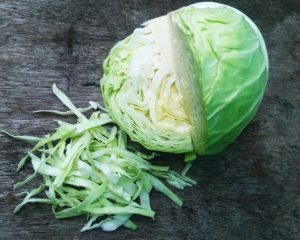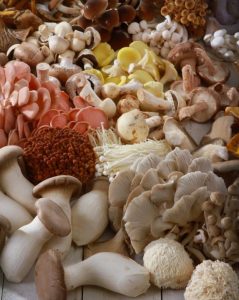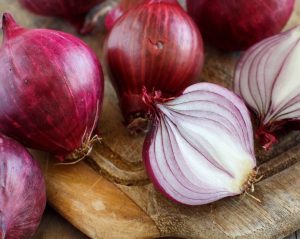I love when my freezer is stocked with real food I can trust—pastured meats like ground beef, sausage, and chicken—ready to turn into a simple, nourishing dinner using the local, organic spring vegetables from my Market Box.
It makes dinnertime feel less like a scramble and more like a rhythm—exactly what I need in this busy season.
Cooking seasonal meals with clean, wholesome ingredients grown right here in our community helps me feel grounded and prepared, even on the busiest days.
Because when it’s 4:30 and I don’t have a plan, that’s when stress sneaks in, and I’m more likely to resort to something rushed or disappointing.
But when I’ve got a plan—even a flexible one—I can cook with peace, using what’s on hand and trusting the seasons to guide the menu.
I’m all about flexible plans.
I just need a starting point. That’s what the Easy Meals Meat Bundle this week gives me.
If that sounds like you too, this post is for you.
I’ve gathered some of our favorite spring meals using meats on special this week and fresh local produce from the farm. Use these ideas to fill your Market Box, stock your pantry, and make your week a little more grounded and a lot more delicious.
FEATURED:
MEAL IDEAS FOR YOUR LOCAL ORGANIC FOOD THIS WEEK:
Many of these recipes include produce or other items you may have received in your market box. You may also see ingredients you can purchase at the WHF General Store. Experiment and see what you can use to create your meal plan!
💡Pro tip: Always check your recipes to see what you have and what you need to purchase. Takes a few extra minutes in planning, but it beats finding out at the last minute that you’re missing ingredients!
🍽️ Cook With the Season: Spring Meals Featuring Sale Meats and Local, Organic Produce
Take advantage of our current meat specials and build simple, satisfying meals around what’s in your market box. These meal plans highlight flavorful cuts like ground beef, Italian sausage, and chicken thighs—paired with fresh, in-season produce and pantry-friendly staples. It’s a great way to cook resourcefully and deliciously, without overthinking dinner.
- 💡Tip: Of course, not everyone will have the exact same items in their box. These meal plans are designed to work using whatever you happen to have on hand. Don’t be afraid to substitute and experiment!
- 🍄🟫 Mushroom Tip: If you picked up our Artisan Mushroom Sampler, you can easily substitute or enhance the cremini or portobello mushrooms in these recipes. Whether you get oyster, enoki, trumpet, shiitake, or Lion’s Mane, just slice and sauté gently with garlic and green onion to bring extra umami to pastas, stir-fries, and bowls.
- 🥬 Note: Curtido is a lightly fermented Salvadoran slaw—tangy, crunchy, and perfect with rich meats or tacos. It’s usually made with cabbage, carrots, and oregano, and pairs beautifully with many of the meals below. Here’s a quick curtido recipe if you want to try it.
Ground Beef – 4 Spring Meals
🍔 Burger Night
- Main Dish: Grass-fed burgers on brioche buns, topped with sautéed mushrooms, and a fried egg (optional).
- 🥚Optional: Add a fried egg on top of your burger.
- Cooked Veg Side: Roasted fingerling sweet potatoes with garlic chives and green garlic.
- Salad: Loose leaf lettuce with shaved watermelon radish, Fuji apple matchsticks, and lemon vinaigrette.
- Fermented Veg: Classic curtido or green cabbage kraut.
- Bread: Brioche buns (used for burgers).
🌮 Taco Bowl
- Main Dish: Ground beef taco-seasoned with green garlic, served over rice with shredded bok choi, green cabbage, and watermelon radish.
- 🥚Optional: Add a fried egg on top of your bowl.
- Cooked Veg: Sautéed spinach and Tuscan kale with cumin and garlic chives.
- Salad: Red cabbage and orange slaw with ginger-lime dressing.
- Fermented Veg: Fermented bok choi or cabbage.
- Bread: Serve with toasted ancient grain tortilla wedges.
🥣 Hearty Soup & Bread Night
- Main Dish: Ground beef and mushroom soup with green onions, bok choi, celery, and mushrooms.
- Cooked Veg: Soup includes veg. Serve extra roasted red beets on the side if desired.
- Salad: Watercress, grapefruit, and watermelon radish with olive oil vinaigrette.
- Fermented Veg: Red cabbage kraut.
- Bread: French country or olive rosemary.
🧆 Herbed Meatballs with Green Sauce
- Main Dish: Ground beef meatballs with garlic chives and green garlic, served with chimichurri or spring herb sauce.
- Cooked Veg: Roasted red beets and sautéed spinach.
- Salad: Loose leaf lettuce with Fuji apple and watermelon radish.
- Fermented Veg: Curtido or fermented green cabbage.
- Bread: Ancient grain or walnut.
~~~
Italian Pork Sausage – 3 Spring Meals
🍽️ Italian Sausage Sheet Pan Dinner
- Main Dish: Sheet pan sausage and roasted vegetables – Italian sausage links roasted with celery, green cabbage wedges, bok choi, and green onions. Add sweet potatoes to the sheet pan, if desired.
- Cooked Veg Side: Add fingerling sweet potatoes to the sheet pan, if desired.
- Salad: Shredded red beet and apple salad with watercress and green onion.
- Fermented Veg: Fermented asparagus spears.
- Bread: Italian einkorn or baguette.
🍝 Pasta Night
- Main Dish: Italian sausage cooked with cremini mushrooms, garlic chives, and green garlic over pasta.
- Cooked Veg: Sautéed Tuscan kale with lemon and olive oil.
- Salad: Lettuce with mandarin orange, shaved radish, and honey-lemon vinaigrette.
- Fermented Veg: Curtido.
- Bread: Italian einkorn or French country.
🌭Sausage Sandwiches
- Main Dish: Grilled sausage on brioche buns with sautéed green onions and mustard.
- Cooked Veg: Grilled cremini mushrooms and celery.
- Salad: Loose leaf lettuce with grapefruit, green onion, and sliced watermelon radish.
- Fermented Veg: Sauerkraut.
- Bread: Brioche buns.
~~~
Maple Breakfast Sausage – 3 Spring Meals
🍁 Brunch Plate
- Main Dish: Maple sausage links, scrambled eggs with green garlic and spinach, and roasted fingerling sweet potatoes.
- Cooked Veg Side: Sautéed rhubarb and/or apples (Crimson Topaz or Evercrisp) with a touch of ginger, cinnamon, and honey.
- Salad: Watercress, orange segments, and shaved watermelon radish with a honey-lemon vinaigrette.
- Fermented Veg: Curtido or pickled red cabbage.
- Bread: Toasted honey wheat Pullman slices.
🥗 Salad & Sausage Supper
- Main Dish: Chilled sausage slices over a robust salad of spinach, arugula, green onions, and grapefruit.
- 🥚Optional: Add a fried or jammy egg on top of the salad dish. Or serve deviled eggs on the side.
- Cooked Veg: Steamed beets with citrus zest.
- Salad: Main dish.
- Fermented Veg: Asparagus or bok choi.
- Bread: Walnut or ancient grain.
🥘 Savory Breakfast-for-Dinner Bowl
- Main Dish: Chopped maple sausage with sautéed greens and sweet potato hash.
- 🥚Optional: Add a fried or poached egg on top.
- 💡Tip: Substitute or add red beets to the hash for a different twist.
- Cooked Veg: Hash includes dandelion greens, Tuscan kale, and bok choi.
- Salad: Loose leaf lettuce with Fuji apples and lemon vinaigrette.
- Fermented Veg: Curtido or kraut.
- Bread: Toasted bagels or alpine rye slices.
~~~
Ground Pork – 3 Spring Meals
🥢 Stir-Fry Bowl
- Main Dish: Stir-fried ground pork with garlic chives, green onions, ginger, bok choi, and red/green cabbage. Serve over rice or noodles.
- 🍳Optional: Add a fried or jammy egg on top of the stir-fry bowl.
- Cooked Veg Side: Steamed spinach and dandelion greens with lemon and garlic.
- Salad: Loose leaf lettuce with shredded beet, sliced mandarin, and a light vinaigrette.
- Fermented Veg: Kimchi-style fermented greens or curtido.
- Bread Note: Stir-fry bowls aren’t traditionally served with bread. Serving over steamed white or brown rice or noodles would work best here.
🥣 Pork & Mushroom Soup
- Main Dish: Ground pork, cremini mushrooms, celery, and garlic chive soup.
- Cooked Veg: Soup-based. Serve roasted beets or cabbage wedges on side.
- Salad: Watercress with apple and radish.
- Fermented Veg: Bok choi kraut or kimchi.
- Bread: Olive rosemary or baguette.
🥬 Pork Lettuce Wraps
- Main Dish: Seasoned pork in lettuce cups with shredded bok choi, radish, and green onion.
- 🥚 Optional: Serve sliced boiled egg on the side.
- Cooked Veg: Roasted mushrooms and celery.
- Salad: Main dish includes salad element.
- Fermented Veg: Curtido or kimchi.
- Bread Note: Pork lettuce wraps aren’t traditionally served with bread. A side of steamed white or brown rice would complement the wraps well. Rice cakes would also be a fun option.
~~~
Chicken Leg & Thigh Packs – 3 Spring Meals
🍗 Roasted Chicken Dinner
- Main Dish: Roasted chicken legs and thighs with a dry rub of garlic, ginger, and citrus zest.
- Cooked Veg Side: Roasted cremini mushrooms, celery, asparagus, and sweet potato.
- Salad: Spinach and arugula with grapefruit, green onion, and olive oil vinaigrette.
- Fermented Veg: Fermented bok choi or classic curtido.
- Bread: Alpine rye or walnut sourdough.
- 🥚Optional: Add your favorite deviled eggs as a starter or side, especially if you’re cooking for a crowd.
🥘 Chicken & Cabbage Skillet
- Main Dish: Pan-seared chicken with sautéed red and green cabbage, green garlic, and bok choi.
- Cooked Veg: Mixed in skillet. Add sauteed asparagus spears on side with a squeeze of lemon or a splash of balsamic vinegar.
- Salad: Loose leaf lettuce with sliced apple, green onion, and vinaigrette.
- Fermented Veg: Red cabbage kraut.
- Bread: French country or Italian einkorn.
🍜 Chicken Noodle Bowl
- Main Dish: Shredded chicken thigh over noodles with broth, garlic chives, mushrooms, and spinach.
- 🥚Optional: Serve a soft-boiled egg on top.
- Cooked Veg: In soup. Add roasted sweet potato on side.
- Salad: Watercress with mandarin and shaved radish.
- Fermented Veg: Curtido or dill sauerkraut.
- Bread: Toasted ancient grain or baguette.
PANTRY RECOMMENDATIONS:
Take a look at the menu plans above for your bread, dairy, and meat recommendations this week.
Based on these plans, check your pantry and add what you need to your market box order. We’ve included a few suggestions and tips below.
- Rice, pasta, quinoa, or other grains.
- Vinegars, olive oil, spices, and seasonings.
- Condiments such as mustard, ketchup, sriracha, salad dressings, and more.
- 💡Tip: If you prefer to try making your own, check out our spring salad dressing recipes. Check your pantry for ingredients.
- Ferments and pickles – we have a great selection!
- 💡Tip: Want to ferment your own veggies? It’s easy! Our Ferment Any Vegetable guide will help you.
- Don’t forget to try our new peanut and almond butters.
- 💡Tip: If you missed our post on ideas for using nut butters, check it out now!
🫖🍯🌱🌺Visit our Mother’s Day page for special brunch and tea bundles and great gift ideas.
🎁💐Stop in and visit us at WHF General Store for your Mother’s Day meal needs. We also have cards, flowers, treats, and unique locally-made gifts!
FRUIT:
Storage for all apple varieties: Keep unwashed apples in a plastic bag in the refrigerator’s crisper drawer, where they can stay fresh for up to two weeks.
 Apple, Crimson Topaz – Crimson Topaz is a striking red apple with a tangy-sweet flavor, originally bred in the Czech Republic and now grown in small quantities elsewhere. It’s an organic grower’s favorite thanks to its natural disease resistance. Nutritionally, it’s similar to other apples – low in calories, high in fiber, and rich in vitamin C and antioxidants from its deep red skin. Crimson Topaz apples are great for fresh eating if you like a sharper bite, and they add depth to salads and cheese boards. They also bake beautifully, adding tartness to pastries and tarts.
Apple, Crimson Topaz – Crimson Topaz is a striking red apple with a tangy-sweet flavor, originally bred in the Czech Republic and now grown in small quantities elsewhere. It’s an organic grower’s favorite thanks to its natural disease resistance. Nutritionally, it’s similar to other apples – low in calories, high in fiber, and rich in vitamin C and antioxidants from its deep red skin. Crimson Topaz apples are great for fresh eating if you like a sharper bite, and they add depth to salads and cheese boards. They also bake beautifully, adding tartness to pastries and tarts.
 Apple, EverCrisp – EverCrisp apples are a hybrid of Honeycrisp and Fuji, combining the crisp texture of the former with the sweetness and dense flesh of the latter. Developed for late-season storage, they retain their crunch and flavor for months when kept cold. Nutritionally, EverCrisp apples offer about 80–100 calories per medium apple, with around 4 grams of fiber and a good dose of vitamin C. They’re excellent for snacking due to their satisfying crunch and balanced sweetness, but also hold up well in pies, crisps, and slaws.
Apple, EverCrisp – EverCrisp apples are a hybrid of Honeycrisp and Fuji, combining the crisp texture of the former with the sweetness and dense flesh of the latter. Developed for late-season storage, they retain their crunch and flavor for months when kept cold. Nutritionally, EverCrisp apples offer about 80–100 calories per medium apple, with around 4 grams of fiber and a good dose of vitamin C. They’re excellent for snacking due to their satisfying crunch and balanced sweetness, but also hold up well in pies, crisps, and slaws.
 Apple, Fuji – Fuji apples are sweet, crisp, and juicy, with a dense texture, making them a popular snacking apple. They are rich in dietary fiber, vitamin C, and antioxidants, which support digestion, immune health, and skin vitality. Fuji apples can be eaten fresh, added to salads, baked into desserts, or cooked into sauces.
Apple, Fuji – Fuji apples are sweet, crisp, and juicy, with a dense texture, making them a popular snacking apple. They are rich in dietary fiber, vitamin C, and antioxidants, which support digestion, immune health, and skin vitality. Fuji apples can be eaten fresh, added to salads, baked into desserts, or cooked into sauces.
 Grapefruit – Grapefruit is a citrus fruit known for its juicy, tangy-sweet flavor with a slight bitterness. It is rich in vitamin C, fiber, and antioxidants like lycopene, promoting immune health, heart health, and skin health. Grapefruit can be eaten fresh, added to salads, or juiced for a refreshing drink. Store whole grapefruit at room temperature for up to a week or in the refrigerator for up to three weeks.
Grapefruit – Grapefruit is a citrus fruit known for its juicy, tangy-sweet flavor with a slight bitterness. It is rich in vitamin C, fiber, and antioxidants like lycopene, promoting immune health, heart health, and skin health. Grapefruit can be eaten fresh, added to salads, or juiced for a refreshing drink. Store whole grapefruit at room temperature for up to a week or in the refrigerator for up to three weeks.

Lemon – Lemons are tangy citrus fruits packed with vitamin C, antioxidants, and citric acid, which aid digestion, boost immunity, and enhance skin health. They are commonly used to add flavor to beverages, marinades, dressings, and desserts or as a natural cleaning agent. Store lemons at room temperature if using them soon or refrigerate them in a perforated bag to extend their shelf life up to 3-4 weeks.
Orange, Mandarin – These small, sweet citrus fruits have a thin, easy-to-peel skin. They are high in vitamin C, fiber, and flavonoids, supporting immune function, digestion, and heart health. Mandarins are perfect for snacking, adding to desserts, or tossing into salads. Store them at room temperature for a few days or refrigerate to extend freshness for up to two weeks.

Orange, Navel – Navel oranges are sweet, seedless, and easy to peel, making them an excellent snack or addition to salads and desserts. They are high in vitamin C, fiber, and antioxidants, which promote immune health and support heart health. Store navel oranges at room temperature for up to a week or refrigerate them in a mesh bag for up to three weeks to maintain freshness. Wash before peeling or slicing.
Organic Veggies We Harvested This Week:
To help you use everything in your box this week, use this Meal Planning Guide to keep track of what’s in the fridge, what needs to be used first, and what you have planned or prepped for each day.
Every member’s customized Market Box is unique, so we hope you will take advantage of more varieties of vegetables as you get comfortable with all the great organic produce we are offering.
Tessa’s Tips
What to use first: chives, green onions, green garlic, salad greens, mushrooms
Longest Storage: apples, beets, carrots, potatoes
Pro-tip: Look at the items in your market box right away and decide how you will use them in your meal planning for the week. Freeze any veggies you know you won’t be able to eat in the week.
Arugula – This leafy green has a peppery, slightly bitter flavor and is commonly used in salads, sandwiches, and as a garnish. It is low in calories and packed with vitamins A, C, and K, as well as folate and antioxidants, which support eye health, immune function, and bone strength. Arugula can be eaten fresh or lightly wilted in pasta dishes and pizzas. Some prefer to eat it tossed with other fresh greens or lettuce so that the spicy taste is not as strong. Putting it on a sandwich is another delicious way to enjoy its distinct flavor. Store wrapped in a paper towel inside a loosely sealed plastic bag in the refrigerator crisper drawer. Properly stored, arugula can stay fresh for up to 3-5 days. For best quality, use arugula soon after purchasing.
💡Tip: Arugula isn’t just for salad. Here are 29 Ways to Eat Arugula including pasta dishes, pizza, sandwiches, and more.
 Asparagus – This spring vegetable is prized for its tender, nutrient-packed stalks. Rich in vitamins A, C, E, K, and folate, asparagus is also a good source of fiber and antioxidants. Its mild, earthy flavor makes it versatile in various dishes, from grilling and roasting to adding to pastas and salads. Asparagus is available in green, white, and purple varieties, with the green being the most common. Store fresh asparagus upright in a jar with a little water in the fridge, or wrapped in a damp towel inside a plastic bag, and use within 3–5 days for the best taste and texture.
Asparagus – This spring vegetable is prized for its tender, nutrient-packed stalks. Rich in vitamins A, C, E, K, and folate, asparagus is also a good source of fiber and antioxidants. Its mild, earthy flavor makes it versatile in various dishes, from grilling and roasting to adding to pastas and salads. Asparagus is available in green, white, and purple varieties, with the green being the most common. Store fresh asparagus upright in a jar with a little water in the fridge, or wrapped in a damp towel inside a plastic bag, and use within 3–5 days for the best taste and texture.
Fun Fact: Asparagus is one of the few vegetables that comes in multiple colors! The green variety is the most commonly consumed, but purple asparagus is sweeter, while white asparagus, grown underground to avoid sunlight, has a milder flavor and more delicate texture.
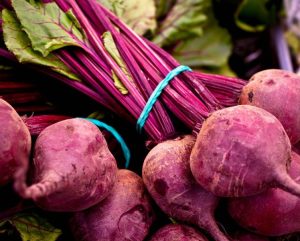
Beet, Red – Red beets are root vegetables known for their earthy flavor and vibrant red-purple color. They are rich in nutrients like folate, manganese, potassium, dietary fiber, and antioxidants such as betalains, which help reduce inflammation and support heart health. Both the roots and greens are edible, with the greens offering additional nutrients like vitamins A and C. Beets can be eaten raw in salads, roasted, boiled, or blended into smoothies and soups. Store beet greens separately from the root, wrapped in a damp cloth or in a plastic bag in the fridge. Use within a few days – they don’t keep long. Beetroots can be stored in a plastic bag in the fridge’s crisper drawer for up to two weeks. To freeze beets for longer storage, slice or chop them, spread on a cookie sheet to flash freeze, then transfer to freezer bags where they can be stored for up to a year.
Cabbage, Green – Green cabbage is a nutrient-dense cruciferous vegetable in the Brassica family, known for its tightly packed, round, pale green leaves. It is rich in vitamins C and K, as well as fiber and antioxidants, which are beneficial for immune health, digestion, and bone strength. With a mild, slightly peppery taste, green cabbage can be enjoyed raw in salads and slaws, or cooked in stir-fries, soups, and stews. To store, keep green cabbage unwashed in a perforated plastic bag in the refrigerator’s crisper drawer, where it can stay fresh for up to two weeks.
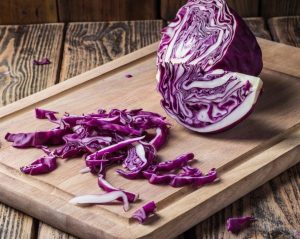 Cabbage, Red – Red cabbage is a vibrant vegetable with a slightly peppery and sweet flavor. It is rich in vitamins C and K, fiber, and antioxidants like anthocyanins, which support immune health, digestion, and reduce inflammation. Red cabbage can be eaten raw in salads and slaws, pickled, or cooked in stir-fries, soups, and stews. Store it in the refrigerator, unwashed, in a plastic bag, where it can stay fresh for up to two weeks.
Cabbage, Red – Red cabbage is a vibrant vegetable with a slightly peppery and sweet flavor. It is rich in vitamins C and K, fiber, and antioxidants like anthocyanins, which support immune health, digestion, and reduce inflammation. Red cabbage can be eaten raw in salads and slaws, pickled, or cooked in stir-fries, soups, and stews. Store it in the refrigerator, unwashed, in a plastic bag, where it can stay fresh for up to two weeks.
💡Tip: Try using red cabbage to make quick pickled cabbage. Thinly slice the cabbage, then toss it with vinegar, lime juice, a pinch of sugar, and spices like cumin or chili flakes. Let it sit for 30 minutes to develop flavor. The result is a tangy, crunchy topping that adds both texture and a pop of color to your meal. Perfect for tacos, burgers, or grain bowls!
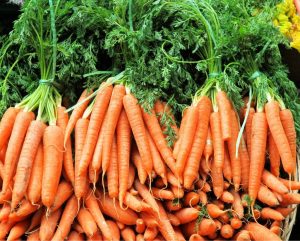 Carrot – Carrots are a versatile and popular root vegetable, known for their sweet, crunchy texture and vibrant orange color, though they can also be found in purple, yellow, and red varieties. They are rich in beta-carotene, which the body converts to vitamin A, essential for good vision and immune health. Carrots are a good source of dietary fiber, potassium, and antioxidants. Enjoy them raw, cooked, roasted, or juiced. They can be used in salads, soups, stews, and side dishes. For optimal storage, store carrots unwashed in the fridge, preferably in a plastic bag or container to maintain moisture, where they can last for several weeks. If the greens are attached, cut them off to prevent the carrots from becoming limp. Stored properly, they should last around 1-2 weeks.
Carrot – Carrots are a versatile and popular root vegetable, known for their sweet, crunchy texture and vibrant orange color, though they can also be found in purple, yellow, and red varieties. They are rich in beta-carotene, which the body converts to vitamin A, essential for good vision and immune health. Carrots are a good source of dietary fiber, potassium, and antioxidants. Enjoy them raw, cooked, roasted, or juiced. They can be used in salads, soups, stews, and side dishes. For optimal storage, store carrots unwashed in the fridge, preferably in a plastic bag or container to maintain moisture, where they can last for several weeks. If the greens are attached, cut them off to prevent the carrots from becoming limp. Stored properly, they should last around 1-2 weeks.
Celery – Celery is a crunchy, low-calorie vegetable known for its mild, slightly salty flavor. It is rich in vitamins K and C, folate, potassium, and fiber, supporting bone health, digestion, and hydration. Celery is often eaten raw as a snack, added to salads, or used as a base in soups, stews, and stir-fries. Store celery in the refrigerator, tightly wrapped in aluminum foil to retain its crispness, where it can stay fresh for up to two weeks. For longer storage, celery can be chopped and frozen.
💡Tip: Don’t forget to use those celery greens! They’re a great addition to cooked beans, salads, eggs. Use leaves to make pesto or dry them and make your own parsley flakes, powder, or salt.
 Dandelion Greens, Red – A striking and slightly more tender variety of traditional dandelion greens, red dandelion greens are easily recognized by their deep green leaves and vivid reddish-purple stems and veins. Like their green-stemmed counterparts, they’re packed with vitamins A, C, and K, calcium, and antioxidants, but red dandelion greens tend to have a slightly milder bitterness and can be more visually appealing in dishes. Their bold color and flavor shine when lightly sautéed with garlic, added to soups or pasta, or eaten raw in salads (especially when balanced with citrus or fruit). Store unwashed greens in a loosely sealed bag with a damp paper towel in the fridge, using within 3–5 days for best quality.
Dandelion Greens, Red – A striking and slightly more tender variety of traditional dandelion greens, red dandelion greens are easily recognized by their deep green leaves and vivid reddish-purple stems and veins. Like their green-stemmed counterparts, they’re packed with vitamins A, C, and K, calcium, and antioxidants, but red dandelion greens tend to have a slightly milder bitterness and can be more visually appealing in dishes. Their bold color and flavor shine when lightly sautéed with garlic, added to soups or pasta, or eaten raw in salads (especially when balanced with citrus or fruit). Store unwashed greens in a loosely sealed bag with a damp paper towel in the fridge, using within 3–5 days for best quality.
Fun Fact: Despite the name, red dandelion greens aren’t true dandelions — they’re actually a type of chicory! But their similar leaf shape and bitter flavor earned them the name.
 Garlic Chives – Garlic chives are a member of the onion family, but with a distinct garlic flavor. Their long, flat leaves are a milder, more delicate alternative to garlic cloves and can be used both raw and cooked. Nutritionally, garlic chives are rich in vitamins A and C, calcium, and antioxidants. These versatile greens work wonderfully in salads, soups, stir-fries, or as a garnish for almost any savory dish. Store garlic chives in the fridge wrapped in a damp paper towel inside a plastic bag, and use them within 5–7 days.
Garlic Chives – Garlic chives are a member of the onion family, but with a distinct garlic flavor. Their long, flat leaves are a milder, more delicate alternative to garlic cloves and can be used both raw and cooked. Nutritionally, garlic chives are rich in vitamins A and C, calcium, and antioxidants. These versatile greens work wonderfully in salads, soups, stir-fries, or as a garnish for almost any savory dish. Store garlic chives in the fridge wrapped in a damp paper towel inside a plastic bag, and use them within 5–7 days.
Fun Fact: Garlic chives are also known as “Chinese chives” and are used widely in Asian cuisine. They can be used to make a flavorful chive oil, perfect for drizzling on dishes like dumplings or noodle soups.
 Green Garlic – Green garlic is simply young garlic harvested before the bulbs fully form. Its flavor is less intense than mature garlic, with a milder, fresher taste that is both garlicky and onion-like. Green garlic is a great source of vitamins A, C, B6, and minerals like manganese and calcium. It can be used in any recipe that calls for garlic, from sautés to soups, or used raw in dressings and pestos. Store green garlic in the fridge, ideally in a dry container with some airflow, and use it within a week for the freshest taste.
Green Garlic – Green garlic is simply young garlic harvested before the bulbs fully form. Its flavor is less intense than mature garlic, with a milder, fresher taste that is both garlicky and onion-like. Green garlic is a great source of vitamins A, C, B6, and minerals like manganese and calcium. It can be used in any recipe that calls for garlic, from sautés to soups, or used raw in dressings and pestos. Store green garlic in the fridge, ideally in a dry container with some airflow, and use it within a week for the freshest taste.
Fun Fact: Green garlic is a seasonal treat, available only in the spring. While it looks like a scallion or young leek, its flavor is distinctly garlic—making it a great ingredient for early spring recipes!
Ginger – Ginger is a flavorful root widely used as a spice and natural remedy. It has a warm, slightly spicy taste and is rich in bioactive compounds like gingerol, which has anti-inflammatory and antioxidant properties. Ginger aids digestion, relieves nausea, and supports immune health. It is versatile in cooking and used in teas, curries, stir-fries, baked goods, and beverages. Store fresh ginger in a cool, dry place for short-term use or in the refrigerator in a paper towel or airtight bag for extended freshness. For long-term storage, freeze peeled or sliced ginger.
💡Tip: Freeze your fresh ginger for longer storage: Peel and slice or grate the ginger. Freeze in an airtight container or ice cube tray. You can also freeze the whole unpeeled root in a freezer bag. Grate or slice directly from frozen as needed.
 Green Onions – Green onions, also known as scallions, have a mild, slightly sweet onion flavor and are packed with vitamins A and K. They are often used raw in salads, salsas, and garnishes but also add depth to stir-fries, soups, and omelets. Their green tops and white bulbs are both edible, making them a versatile ingredient. Store in the refrigerator, wrapped in a damp paper towel inside a bag, or stand them in a jar of water to keep them fresh longer.
Green Onions – Green onions, also known as scallions, have a mild, slightly sweet onion flavor and are packed with vitamins A and K. They are often used raw in salads, salsas, and garnishes but also add depth to stir-fries, soups, and omelets. Their green tops and white bulbs are both edible, making them a versatile ingredient. Store in the refrigerator, wrapped in a damp paper towel inside a bag, or stand them in a jar of water to keep them fresh longer.

Lettuce, Loose Leaf – Leaf lettuce, known for its loose, leafy structure and mild, slightly sweet flavor, comes in green and red varieties. It is a low-calorie vegetable packed with vitamins A, C, and K, as well as folate and fiber, making it a nutritious choice for salads and wraps. Its tender leaves are best used raw in salads, sandwiches, or as a garnish. Store leaf lettuce in the refrigerator, loosely wrapped in a damp paper towel inside a plastic bag or container, and use it within a week to maintain freshness and crispness.
💡Tip: Don’t miss this exclusive Weekly Salad Greens Subscription to get the freshest greens in the Lehigh Valley every week!
Mushroom Varieties
Store mushrooms in a paper bag or breathable container in the refrigerator, avoiding moisture buildup, and only wash them right before use to maintain freshness.
Mushrooms are super versatile in the kitchen. Here are 10 Things You Should Do With Mushrooms.
This roundup of 20 Mushroom Recipes has you covered with meal ideas for breakfast, lunch, or dinner.
Mushroom, Portobello & Cremini – Portobello mushrooms are mature versions of cremini mushrooms, offering a meaty texture and rich, earthy flavor. Cremini, also known as “baby bellas,” are younger, smaller, and have a firmer texture with a milder taste. Both are low in calories, fat-free, cholesterol-free, and provide B vitamins, selenium, potassium, and antioxidants. Portobellos are ideal for grilling, roasting, or as a meat substitute in burgers, sandwiches, or stuffed recipes. Creminis are great for sautéing, adding to soups, stir-fries, pasta dishes, or as pizza and salad toppings.
💡Tip: The artisan mushroom sampler is a great way to try different varieties of mushrooms. While we can’t predict or guarantee what will be included, the sampler often includes varieties such as enoki, oyster, shiitake, or trumpet mushrooms!
Onion, Red – Red onions are a vibrant, mildly sweet onion variety with a sharp bite, commonly used raw or cooked in various dishes. They are a good source of vitamin C, antioxidants, and fiber, contributing to overall health and supporting the immune system. Red onions add color and flavor to salads, salsas, sandwiches, pickles, and roasted vegetable dishes. Store whole red onions in a cool, dry, well-ventilated space away from sunlight; once cut, refrigerate in an airtight container and use within a few days to preserve freshness.
Fun Fact: Red onions get their color from anthocyanins, which can turn bluish-green when cooked with alkaline foods such as some beans and legumes. Adding a little acid (like vinegar or lemon juice) helps keep their color vibrant.
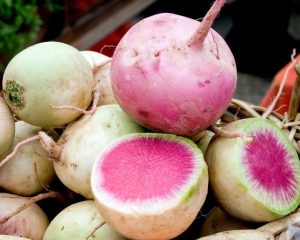 Radish, Watermelon – Watermelon radish is a striking root vegetable with a mild, slightly sweet flavor and a crisp texture. Its pale green skin hides a vibrant pink interior, resembling a watermelon. Rich in vitamin C, potassium, and antioxidants, it supports immune health and reduces inflammation. Watermelon radishes can be enjoyed raw in salads, sliced thinly for garnishes, pickled, or roasted for a milder flavor. Store unwashed watermelon radishes in a perforated plastic bag in the refrigerator, where they can stay fresh for up to two weeks. Wash and trim just before using.
Radish, Watermelon – Watermelon radish is a striking root vegetable with a mild, slightly sweet flavor and a crisp texture. Its pale green skin hides a vibrant pink interior, resembling a watermelon. Rich in vitamin C, potassium, and antioxidants, it supports immune health and reduces inflammation. Watermelon radishes can be enjoyed raw in salads, sliced thinly for garnishes, pickled, or roasted for a milder flavor. Store unwashed watermelon radishes in a perforated plastic bag in the refrigerator, where they can stay fresh for up to two weeks. Wash and trim just before using.
💡Tip: Watermelon radishes make beautiful and delicious chips! Try this easy recipe: Toss thin slices with a little oil and salt, spread on a parchment-lined sheet, and roast at 400°F for 15-20 minutes, flipping halfway through. They’re finished when the edges begin to curl and the radishes turn lightly brown and crispy. Keep an eye on them – they go from perfect to too dark very quickly. Pair finished chips with herbed goat cheese or yogurt, guacamole, or hummus.
 Rhubarb – Rhubarb is a unique perennial vegetable known for its vibrant red or green stalks. While technically a vegetable, it’s most often treated as a fruit in cooking, thanks to its tart, tangy flavor. Rich in vitamin K, fiber, and antioxidants, rhubarb is often used in desserts like pies, crumbles, and jams, though it can also complement savory dishes when paired with meat like pork. The leaves of rhubarb contain toxins and should never be eaten, but the stalks are perfectly safe to enjoy. Store rhubarb in the fridge, wrapped in a damp cloth or in a sealed plastic bag, and use within a week for the best flavor.
Rhubarb – Rhubarb is a unique perennial vegetable known for its vibrant red or green stalks. While technically a vegetable, it’s most often treated as a fruit in cooking, thanks to its tart, tangy flavor. Rich in vitamin K, fiber, and antioxidants, rhubarb is often used in desserts like pies, crumbles, and jams, though it can also complement savory dishes when paired with meat like pork. The leaves of rhubarb contain toxins and should never be eaten, but the stalks are perfectly safe to enjoy. Store rhubarb in the fridge, wrapped in a damp cloth or in a sealed plastic bag, and use within a week for the best flavor.
💡Tip: To reduce rhubarb’s natural tartness, cook it with some sugar or honey, or combine it with sweeter fruits like strawberries in desserts for a balanced flavor.
Fun Fact: Rhubarb was originally used in ancient Chinese medicine for its health benefits, long before it became a culinary favorite!
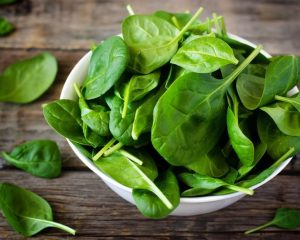 Spinach – Spinach is a nutrient-rich leafy green vegetable packed with vitamins A, C, K, folate, and minerals like iron and magnesium. Low in calories and high in antioxidants, it supports eye health, bone strength, and immune function. Spinach is versatile and can be enjoyed raw in salads, blended into smoothies, or cooked in soups, pasta, and omelets. To store, keep it dry in a perforated plastic bag in the fridge’s crisper drawer, and wash only before use. Properly stored, it stays fresh for 5-7 days.
Spinach – Spinach is a nutrient-rich leafy green vegetable packed with vitamins A, C, K, folate, and minerals like iron and magnesium. Low in calories and high in antioxidants, it supports eye health, bone strength, and immune function. Spinach is versatile and can be enjoyed raw in salads, blended into smoothies, or cooked in soups, pasta, and omelets. To store, keep it dry in a perforated plastic bag in the fridge’s crisper drawer, and wash only before use. Properly stored, it stays fresh for 5-7 days.
Fun Fact: During medieval times, spinach juice was used as ink for artwork due to its rich green pigment.
 Stinging Nettle – This wild, nutrient-rich leafy green is known for its fine, hair-like spines that sting when touched raw, though cooking, drying, or blending neutralizes the sting entirely. It has a mild, earthy flavor similar to spinach and has long been used in both culinary and herbal traditions. Nettles are packed with vitamins A, C, K, and B-complex, as well as iron, calcium, magnesium, potassium, and plant-based protein. They’re popular in soups, pestos, egg dishes, sautéed greens, and teas. Always blanch before eating to remove the sting. Store fresh nettles in the fridge wrapped in a damp paper towel inside a produce bag. Use within a few days, or blanch and either freeze or dry for long-term use.
Stinging Nettle – This wild, nutrient-rich leafy green is known for its fine, hair-like spines that sting when touched raw, though cooking, drying, or blending neutralizes the sting entirely. It has a mild, earthy flavor similar to spinach and has long been used in both culinary and herbal traditions. Nettles are packed with vitamins A, C, K, and B-complex, as well as iron, calcium, magnesium, potassium, and plant-based protein. They’re popular in soups, pestos, egg dishes, sautéed greens, and teas. Always blanch before eating to remove the sting. Store fresh nettles in the fridge wrapped in a damp paper towel inside a produce bag. Use within a few days, or blanch and either freeze or dry for long-term use.
💡Important Tip: Always handle raw nettles with gloves or tongs.
Fun Facts: Stinging nettles aren’t just good for you—they’re good for the planet, too. Nettles grow abundantly without fertilizer and can be harvested multiple times a season. They’re considered a low-impact wild green, especially when foraged responsibly. Plus, they’re a favorite host plant for butterflies like the Red Admiral and Small Tortoiseshell, making them a quiet hero in supporting local pollinators and biodiversity.
 Sweet Potato, Fingerling – Sweet potato fingerlings are small, slender sweet potatoes with thin, edible skin and a naturally sweet, creamy texture. They are rich in fiber, beta-carotene, and vitamin C, promoting digestive and immune health. Roast, sauté, or air-fry them whole for a crispy skin and tender interior, or slice them into fries or hash. Store in a cool, dry place away from light, but avoid refrigeration as it can affect their texture.
Sweet Potato, Fingerling – Sweet potato fingerlings are small, slender sweet potatoes with thin, edible skin and a naturally sweet, creamy texture. They are rich in fiber, beta-carotene, and vitamin C, promoting digestive and immune health. Roast, sauté, or air-fry them whole for a crispy skin and tender interior, or slice them into fries or hash. Store in a cool, dry place away from light, but avoid refrigeration as it can affect their texture.
💡Tip: Roast whole or halved with herbs and spices for a simple side or mash with a touch of butter and cinnamon for a comforting dish.
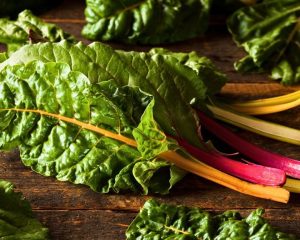 Swiss Chard – Swiss chard is a vibrant leafy green vegetable, rich in vitamins A, C, and K, as well as magnesium, potassium, and iron, making it a nutritious, low-calorie option. The stems come in various colors or simply a whitish green. Both the leaves and the stalks are edible. When picked very young, chard can be part of a green salad. But full-grown chard like in your box today has a very strong flavor and tough stems when eaten raw. Its slightly bitter, earthy flavor pairs well with garlic, lemon, and olive oil, and it can be sautéed or steamed. After cooking for several minutes, it can also be added to rice and beans or omelets. Chard can be sliced or chopped and added to soups. The stems work well in soups, stews, or as a celery substitute. Use Chard any way you would prepare spinach, allowing for longer cooking time for the stems. To store, keep unwashed in a plastic bag or container in the refrigerator’s crisper drawer, using it within 3–5 days; if it wilts, revive it by soaking in cold water before use. Before using, wash well in cool water and separate the leaves from the stems.
Swiss Chard – Swiss chard is a vibrant leafy green vegetable, rich in vitamins A, C, and K, as well as magnesium, potassium, and iron, making it a nutritious, low-calorie option. The stems come in various colors or simply a whitish green. Both the leaves and the stalks are edible. When picked very young, chard can be part of a green salad. But full-grown chard like in your box today has a very strong flavor and tough stems when eaten raw. Its slightly bitter, earthy flavor pairs well with garlic, lemon, and olive oil, and it can be sautéed or steamed. After cooking for several minutes, it can also be added to rice and beans or omelets. Chard can be sliced or chopped and added to soups. The stems work well in soups, stews, or as a celery substitute. Use Chard any way you would prepare spinach, allowing for longer cooking time for the stems. To store, keep unwashed in a plastic bag or container in the refrigerator’s crisper drawer, using it within 3–5 days; if it wilts, revive it by soaking in cold water before use. Before using, wash well in cool water and separate the leaves from the stems.
Fun fact: Chard is in the chenopod family which includes beets, spinach, and quinoa.
 Watercress – Watercress is a peppery, nutrient-dense leafy green packed with antioxidants, vitamins A, C, and K, and beneficial plant compounds. Its crisp, slightly spicy flavor makes it excellent in fresh salads, sandwiches, and as a garnish for soups or main dishes. Store unwashed watercress in a sealed container or produce bag in the fridge for up to 3–5 days; wrap in a damp paper towel to help maintain freshness.
Watercress – Watercress is a peppery, nutrient-dense leafy green packed with antioxidants, vitamins A, C, and K, and beneficial plant compounds. Its crisp, slightly spicy flavor makes it excellent in fresh salads, sandwiches, and as a garnish for soups or main dishes. Store unwashed watercress in a sealed container or produce bag in the fridge for up to 3–5 days; wrap in a damp paper towel to help maintain freshness.
💡Tip: Use watercress in place of arugula or spinach for a sharper bite in salads or on pizza after baking.
Fun Fact: Watercress was once a staple for Roman soldiers and is one of the oldest known leaf vegetables consumed by humans.
Don’t forget: Online shopping opens Friday at 1 PM! 🛒 Stock your kitchen with these clean, nourishing ingredients to fuel your family with nutrient-dense meals. Be sure to grab your favorite staples and try something new for vibrant health this season.
Don’t wait to join…
Veggie E-Books
Download these collections of tips and recipes for each veggie. You’ll use these as a reference throughout the season.
Arugula E-Book
Asparagus E-Book
Beets E-Book
Cabbage E-Book
Carrots E-Book
Fresh Herbs E-Book
Lettuce E-Book
Mushrooms E-Book
Onions E-Book
Potatoes E-Book
Radish E-Book
Scallion/Green Onion E-Book
Spinach E-Book
We’ll keep farming for you!
Reuben and Tessa DeMaster
Willow Haven Farm




